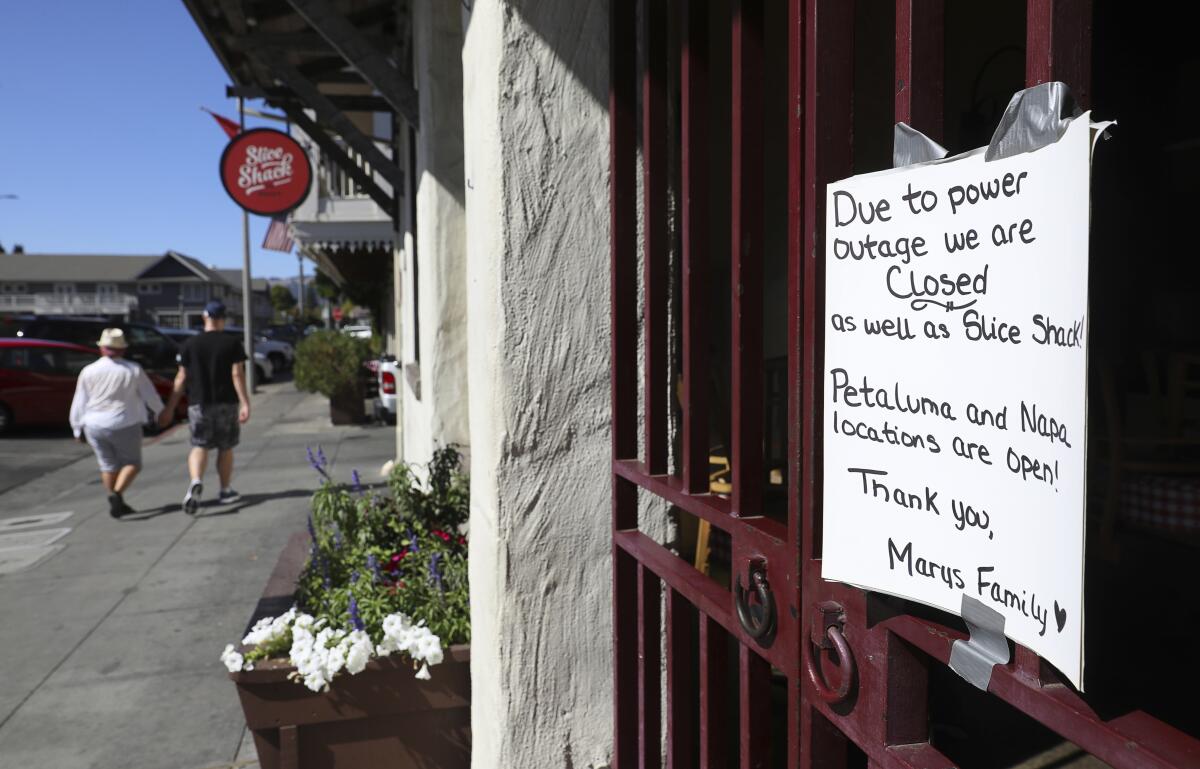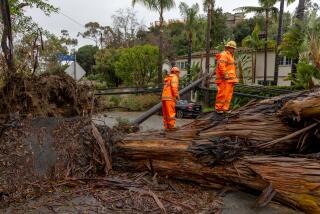What will the next heavy winds bring? Assessing the great power shut-off of 2019

Less than a week after utilities shut off power to hundreds of thousands of customers up and down California, experts and regulators are beginning to assess what went wrong and what the future portends.
Pacific Gas & Electric cut power to more than 700,000 customers in 34 counties early Wednesday because of high winds. Some households were without electricity for 72 hours, a spokesman said. Southern California Edison shut off electricity to more than 24,000 customers, also starting Wednesday.
The biggest failure, experts and customers alike said, was communication. Residents complained they did not receive adequate notice of the shutdown or no notice at all and could not get on the utilities’ websites.
Lessons learned from the shutdowns are critical because more will take place, experts said.
“I suspect for the next few years these are going to occur,” said Severin Borenstein, faculty director of UC Berkeley’s Energy Institute. “No one involved in this thing thinks it was a one-time event.”
The California Public Utilities Commission on Monday ordered PG&E to take immediate corrective actions, and Gov. Gavin Newsom called on the utility to give residential customers who lost power $100 rebates.
Commission President Marybel Batjer told PG&E it must try to restore power within 12 hours in the future, reduce the size of outages, develop systems to ensure call centers and the website are accessible and develop a “communication structure” with counties and tribal governments so they can respond to emergencies.
“Failures in execution, combined with the magnitude of this … event, created an unacceptable situation that should never be repeated,” Batjer said.
After Newsom’s request and the commission’s letter, Bill Johnson, PG&E’s chief executive, said the utility looked forward to learning how it could improve but called the power shut-off “the right decision.”
PG&E spokesman Jeff Smith said the utility cannot determine whether rebates should be given until the utilities commission evaluates the shutdown. He also said PG&E could not rule out more shutdowns later this fall.
Some experts said utilities should not have unilateral power for deciding when to shut off power. Utilities have “too much incentive” to cut power because they bear full liability if their equipment sparks a blaze, Borenstein said.
During a shutdown, the risk shifts. “We bear the cost,” he said.
He said the state should create some sort of committee that includes public safety officials, elected officials, utilities and the Public Utilities Commission to make power shut-off calls in the future.
Utilities have sparked fires for decades, but they are now more destructive because of droughts produced by climate change and the movement of people into more remote, highly vegetated regions, experts said.
Southern California Edison’s customers complained the utility failed to give them adequate warning.
They hit the utility with questions about the timing, criticism over lack of immediate notice and outrage over spoiled food, stress-related health effects and fears that trapped cars beneath electric garage doors would leave people stranded in the event of a fire.
“We strive to keep the customer informed always, but we may not be able to depending on circumstances,” said Edison spokesman Robert Villegas.
UC Berkeley professor Alexandra von Meier, an expert on energy grids, said utilities need to give customers adequate notice to prepare for shutdowns but must weigh that against the fact that weather forecasts are less accurate days in advance.
“The bottom line is no one should be in a situation where they really need to fear the power going out,” she said. “We heard from medical patients with essential needs powered by electricity” who were caught off-guard when the electricity went out. They should be provided with backup power, von Meier said.
Janice Bell, a Chatsworth resident who has multiple sclerosis, lost power Thursday morning. At 4:30 a.m. Friday she heard sirens go past her house as a sheriff instructed people to evacuate because a fire had exploded in Porter Ranch, just two miles away.
But Bell’s car was trapped inside her garage, beneath an electric door, and she could not open it.
After two hours of waiting, she flagged down a neighbor who helped her open the garage door and she drove to her office in Woodland Hills.
Bell is part of Edison’s Medical Baseline program, which offers financial assistance for those who rely on medical equipment. But she said she didn’t receive any advance notice of the power outage through the program. To add further complication, Bell said that Edison’s website was down for two days.
“This was the opposite of responsible,” Bell said. “What about people like me? I live alone. What if the fire was in my backyard? It was two miles away and the winds were blowing 60 mph.”
Villegas said SoCal Edison’s critical care customer program offers people who need further assistance advance warning for outages. But it’s unclear whether most customers in need of such service are aware that the program is available, or if the warning time is enough.
Curtis Child, legislative director of Disability Rights California, said these decisions are left to utility companies without any official direction of how to mitigate the effect on people with disabilities. The standard 48-hour warning is not always enough time for people with disabilities to prepare for backup services, such as alternative respirators or physical assistance, he said.
State Sen. Mike McGuire (D-Healdsburg) said the state needs to force PG&E to speed up efforts to harden its equipment, perform necessary vegetation management and modernize its grid in high-hazard wildfire zones — work anticipated to take a decade to complete.
He and other lawmakers hope to introduce legislation early next year to address several problems related to shut-offs. It could include setting criteria that utilities must meet before flipping off the lights and requiring companies to develop accurate lists of medically fragile patients.
“You’d think the largest electricity utility in America could do better, but it’s obvious that they can’t,” he said.
Rooftop solar panels paired with batteries are one of the most straightforward strategies for coping with a future of fire-driven power outages, experts said. But they noted that investor-owned utilities such as Edison and PG&E don’t have much motivation to push solar-plus-storage as a solution for their customers.
For-profit electric utilities have traditionally seen “behind-the-meter” solar panels as a threat to their bottom line, and have fought to limit financial incentive programs for rooftop systems, arguing that those incentives harm customers unable to afford solar power.
“The utilities will oppose accelerating the deployment of behind-the-meter solar and batteries, even in areas that are subject to the shut-offs, because it’s just so diametrically opposed to their business model,” said Bill Powers, a San Diego electrical engineering consultant and consumer advocate.
Joe Eto, a staff scientist at Lawrence Berkeley National Laboratory, said ratepayers may be asked to bear the costs of improving PG&E’s grid.
It is impossible to know whether PG&E’s decision to cut electricity avoided a wildfire, but the utility reported it found 50 instances of equipment damaged by wind, including downed power lines.
“To the extent they avoided another catastrophic wildfire, that seems like something that is very important,” Eto said.
Dolan reported from San Francisco, Luna from Sacramento and Shalby and Roth from Los Angeles.
More to Read
Start your day right
Sign up for Essential California for news, features and recommendations from the L.A. Times and beyond in your inbox six days a week.
You may occasionally receive promotional content from the Los Angeles Times.










